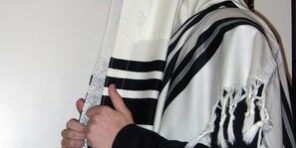Torah: Shelach Lecha (Numbers 13:1-15:42) Haftarah: (Joshua 2:1-24)
The Torah continues with the ten spies and their reports. The children of Israel rebel, the punishment of the children of Israel, rules pertaining to various sacrificial offerings, and Tzitzit- the fringes on the prayer shawl.
The Tallit: Moses instructs the Israelites in this Torah portion to wear tzitzit (fringes) on the corners of their garments throughout their generations. He explains that the fringe is to recall all of G-d’s commandments. Today the prayer shawl has become the four-cornered garment of responsibility, worn by adult males who become Bar Mitzvah and by many young 12 year old females as well known as a Bat Mitzvah. Commenting on the Hebrew word tzitzit, the commentator Rashi notes that its numerical value is 600 (tzadi=90, yud =10, tzadi+90. yud=10, tav=400) and that the fringe is tied with eight threads and five knots. Together the full numerical equivalent comes to 613, which is the total number of commandments in the Torah.
The Tzitzit: The mitzvah of the tzitzit is considered the most important of all mitzvot. The rabbis often equated this one mitzvah with the rest of the 613 . First the Torah reminds one the importance when it says, “When you see it, you shall remember all the mitzvot”
(Numbers 15:39). The Tallit and the tzitzit are constant reminders of our special relationship with G-d. In ancient times the tzitzit had a blue color thread, and making the dye was lost for centuries. Some Jews believe they found the right blue dye for the tzitzit and they tie threads with it. While either way is Kosher/correct, rabbis believe the blue thread resembles the sea, the sea resembles the heavens, and the heavens resemble the Throne of Glory. Therefore looking at the tzitzit is an outward action. The Israelites looking at the tzitzit gave them an inward act of spirituality with the precepts of G-d.
Shabbat Shalom,
Rabbi Helene Ainbinder





